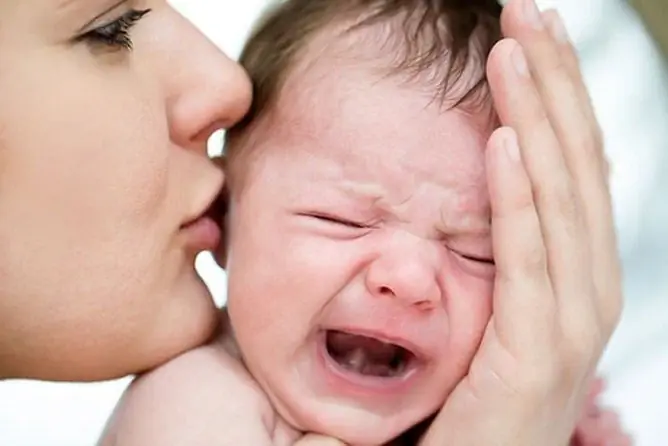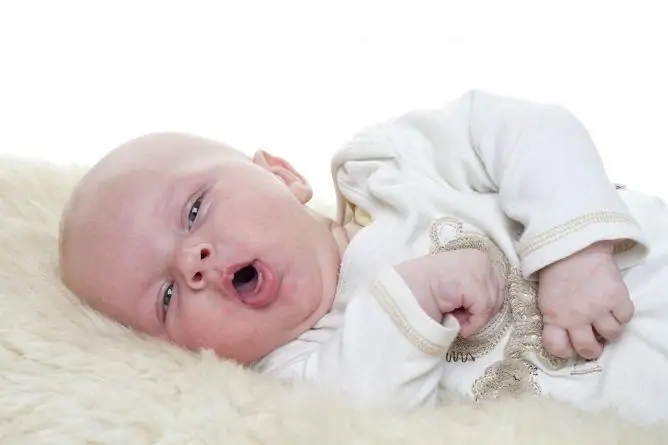- Author Rachel Wainwright [email protected].
- Public 2023-12-15 07:39.
- Last modified 2025-11-02 20:14.
Increased intracranial pressure in infants: symptoms, causes, diagnosis and treatment
The content of the article:
- Signs of intracranial pressure in infants
- Causes and risk factors
- Diagnostics
- Treatment of increased intracranial pressure in children
- Video
Increased intracranial pressure in infants (intracranial hypertension) is a pathological condition that, as a rule, is not an independent disease, but is a sign of a number of diseases.
This is a dangerous condition that can cause severe complications, so it is advisable for parents to be aware of what intracranial hypertension is, why it occurs, how it manifests itself, and also what to do if a child detects signs of the disease.

With high intracranial pressure, the child becomes moody and restless.
Cranial pressure (unlike blood pressure, which can be checked at home) cannot be measured at home. If intracranial hypertension is suspected, an infant should be immediately shown to a doctor, since the pathology is most quickly and effectively treated at an early stage, before the development of irreversible consequences. In the absence of timely adequate treatment, intracranial hypertension can lead to mental retardation, loss of vision, paralysis, epilepsy and other neuropathies, and in severe cases, death.
Signs of intracranial pressure in infants
Symptoms of intracranial pressure in infants are not specific and can be observed in some other pathological conditions.
In infants, increased intracranial pressure is manifested by a decrease in sucking activity, tension and bulging of fontanelles, in which there is no pulsation, dilated head veins, increased muscle tone, and a loud cry. Anxiety in children with intracranial hypertension usually increases in the evening and when lying down. The child may refuse to feed (during the sucking process, intracranial pressure increases), which causes weight loss.
The symptomatology of intracranial hypertension can grow slowly (as a rule, this variant is observed in children aged 2 months to 6 months, in some cases - up to a year), or develop rapidly (usually in children over one year old).
Slowly growing symptoms: frequent regurgitation after eating, profuse vomiting several times a day, regardless of food intake, frequent crying for no apparent reason, shallow sleep, disproportionate head enlargement that does not correspond to the age norm, divergence of the seams between the bones of the skull, developmental delay (children later begin to hold their heads, sit, crawl).
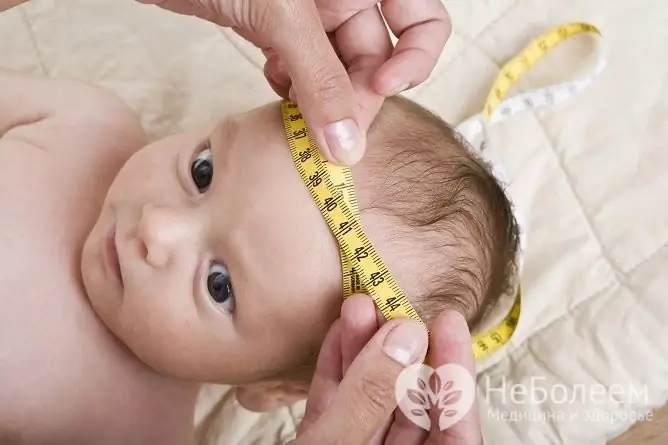
Intracranial hypertension in infants is manifested by an enlargement of the head
A rapid increase in intracranial pressure in children is manifested by non-stop vomiting, convulsions, loss of consciousness. If such signs occur, you should immediately call an ambulance.
Headache with intracranial hypertension in newborns and infants usually appears in the morning. In an upright position, the pain decreases or disappears altogether, as the circulation of cerebrospinal fluid improves.
If the outflow of cerebrospinal fluid is impaired due to organic obstacles, the child may develop impairments of smell, vision, sensitivity, and motor functions. In some cases, endocrine pathologies are noted (overweight, growth retardation, diabetes mellitus). An infant with intracranial hypertension often has limb tremors, chin tremors, squint, and impaired consciousness.
Often, parents consider frequent nosebleeds a sign of increased intracranial pressure in a child. Dr. Komarovsky recalls that this symptom has nothing to do with intracranial hypertension, but most often serves as a manifestation of insufficient hydration of the nasal mucosa.
Causes and risk factors
The immediate causes of an increase in intracranial pressure in a newborn are increased release of cerebrospinal fluid, a low degree of its absorption, a violation of its circulation in the cerebrospinal fluid, an increase in the volume of tissue fluid or blood. Intracranial hypertension develops with meningitis, encephalitis, hydrocephalus, stroke, craniocerebral trauma, injuries with damage to cervical blood vessels, abscesses, severe forms of diabetes mellitus.
Risk factors:
- a history of intrauterine hypoxia;
- pathological childbirth;
- toxicosis in the mother in the last trimester of pregnancy;
- infectious diseases transferred by the mother during pregnancy;
- early life trauma;
- intoxication;
- anomalies in the development of the brain and / or cerebral vessels.
Diagnostics
In order to understand what treatment a child needs for intracranial hypertension, an accurate diagnosis should be made, since this condition is usually a secondary pathology.
If symptoms of intracranial hypertension are detected in children, consultation of a pediatrician (therapist), a neuropathologist, an ophthalmologist is required.
In some cases, probable violations of intracranial pressure in a child can be suspected at the prenatal stage of development when examining a pregnant woman and detecting intrauterine fetal hypoxia. Ultrasound in the last trimester of pregnancy reveals vascular changes that can lead to oxygen starvation and subsequent intracranial hypertension in the child.
Serious pathologies (for example, hydrocephalus), which can cause increased intracranial pressure in newborns and infants, are often identified during the examination of the child by a neonatologist immediately after childbirth. A pathological condition can be suspected during a routine examination.
To diagnose intracranial hypertension, an ultrasound examination of the brain (neurosonography) may be needed - an affordable and safe method that makes it possible to assess the size of the ventricles of the brain as an indirect sign of cranial pressure.
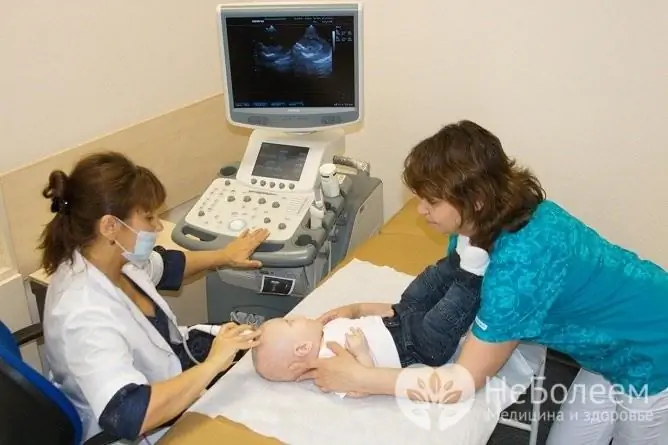
Neurosonography is an effective and safe method for diagnosing intracranial hypertension in infants
In some cases, magnetic resonance imaging or computed tomography is used (usually to exclude serious intracranial pathology), echoencephalography. Magnetic resonance imaging or computed tomography is rarely used, since it is necessary to ensure long-term immobility of the child to obtain high-quality images, which can be difficult. Usually, if such a diagnosis is necessary in children, general anesthesia is used, which can adversely affect the child's condition.
To clarify the diagnosis, an X-ray examination of the brain, a spinal tap may be required.
Ophthalmoscopy is an important stage of diagnosis. During examination of the fundus with intracranial hypertension, there is edema of the optic nerve head, dilatation of the veins of the fundus.
Treatment of increased intracranial pressure in children
First of all, it should be borne in mind that if there is a suspicion of intracranial hypertension, and even more so with proven intracranial hypertension in a child, self-medication is unacceptable. This condition can be a sign of a serious illness, and elimination of symptoms without eliminating the cause can lead to aggravation of the patient's condition, the development of complications and death.
Treatment of intracranial hypertension in infants is complex, depending on the cause and severity of the condition, conservative and surgical methods are used.
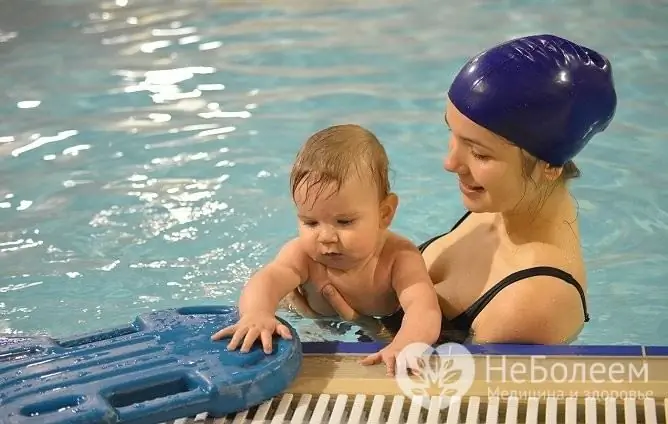
With increased intracranial pressure, babies are shown therapeutic swimming
Drug therapy consists in the use of diuretic and decongestant drugs (Diacarb is often prescribed, which, according to reviews, demonstrates good results in newborns and infants), neuroprotectors. After reducing intracranial pressure, therapy consists of treating the underlying disease.
If the intracranial pressure in the baby is increased against the background of hydrocephalus, tumor, hematoma, surgery may be required.
Surgical treatment consists in removing the neoplasm or bypassing - creating an artificial pathway for the outflow of cerebrospinal fluid. As the child gets older and grows, it may be necessary to lengthen the CSF drain several times.
The main treatment can be supplemented by physiotherapy techniques, massage, folk remedies (herbal infusions, etc.). However, any treatment must be agreed with the attending physician.
In some cases, therapeutic swimming has a good therapeutic effect. Children with intracranial hypertension are encouraged to spend more time outdoors.
The duration of treatment for intracranial hypertension in infants is on average from 3 months to six months.
The prognosis depends on the timeliness of the detection of pathology and treatment, as well as on the primary disease.
Video
We offer for viewing a video on the topic of the article.

Anna Aksenova Medical journalist About the author
Education: 2004-2007 "First Kiev Medical College" specialty "Laboratory Diagnostics".
Found a mistake in the text? Select it and press Ctrl + Enter.

